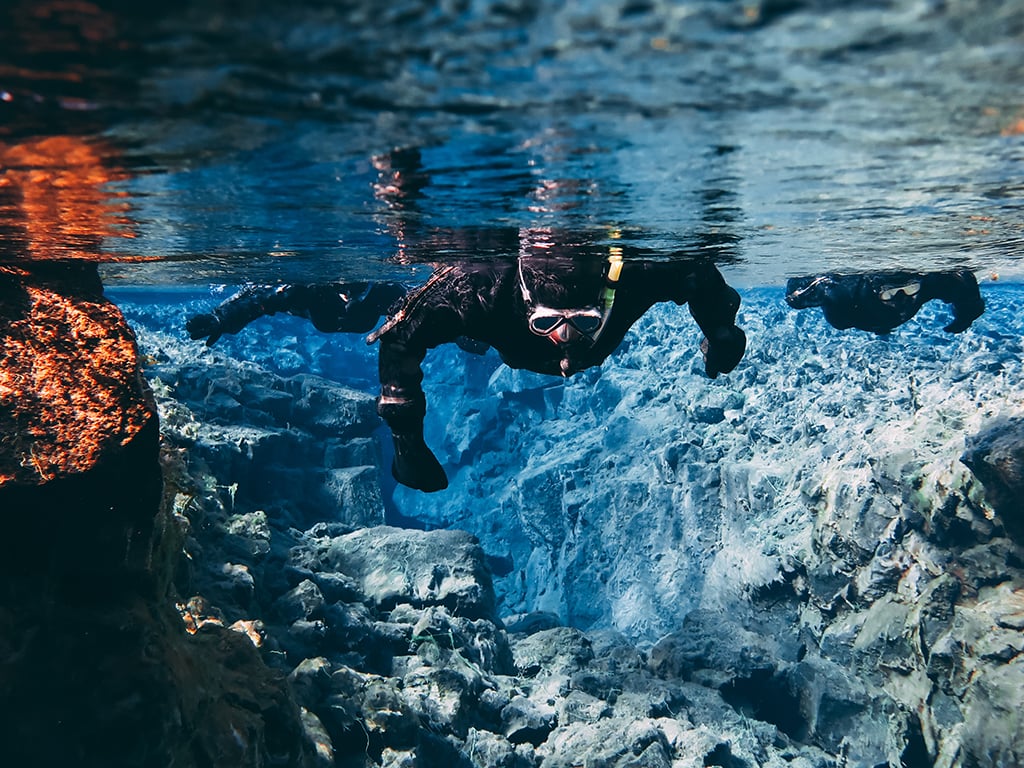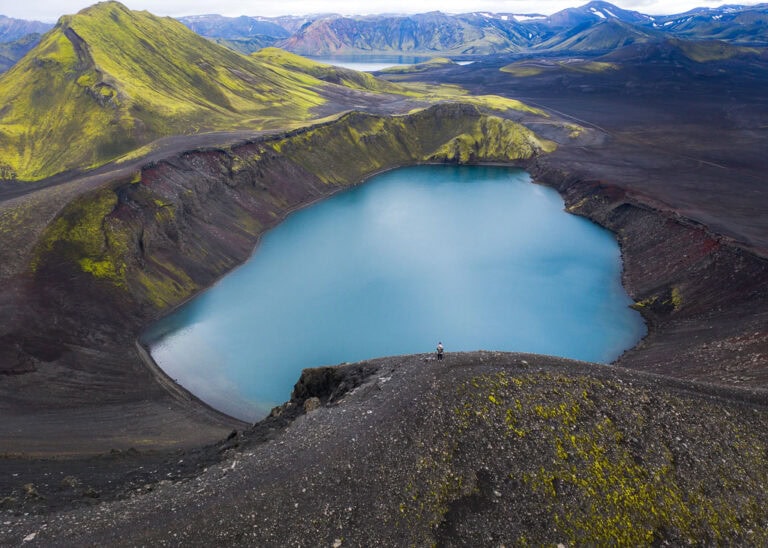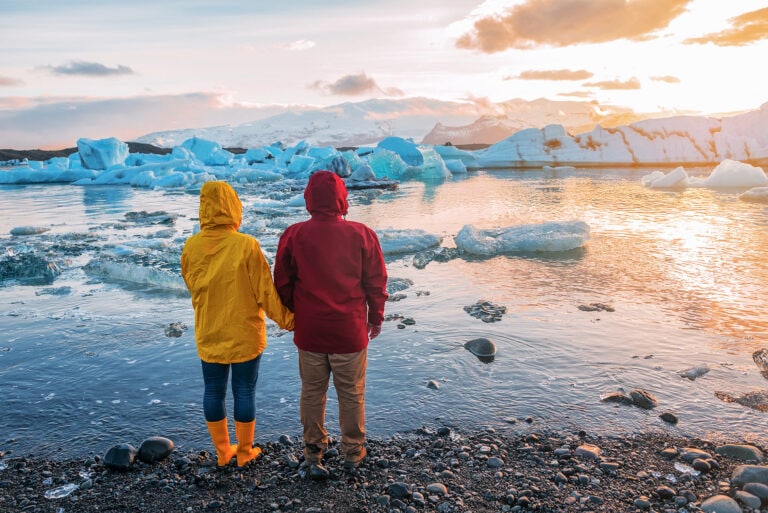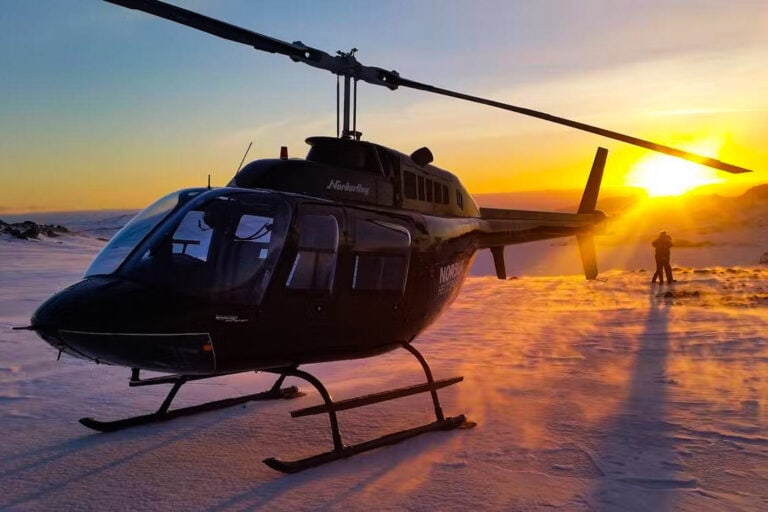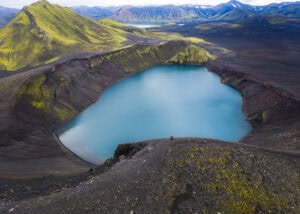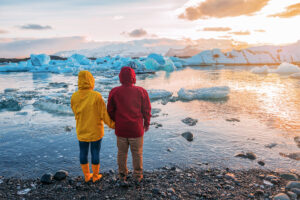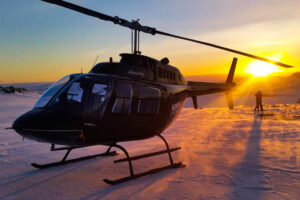Iceland is considered by many to be the world’s most beautiful country. The wide variety of natural wonders available on a tiny island is unsurpassable. Volcanoes, glaciers, lava fields, and black sand beaches, along with valleys and mountains, took right out of a fairytale, offering visitors breathtaking sites all within a short distance of one another.
Due to this, it can be difficult or even overwhelming to try and plan a trip to Iceland. What do you put on your itinerary, and what do you leave off? There are so many things to see and experience that finding a place for everything in one vacation may seem nearly impossible.
Some of the adventures Iceland offers are highly recommended, so you should consider including them in your plans. That’s why in this article, to help you plan, we’re going to share with you our recommendations for sites and activities that we consider the most exciting options to ensure that you don’t miss out on anything during your trip to Iceland.
- 1. Drive an ATV or Buggy across a black desert
- 2. Descend down into a dormant volcano
- 3. Bathe in a tub of geothermal beer in North Iceland
- 4. Go snorkelling or diving between the tectonic plates in the Silfra Fissure
- 5. Go for a swim in the Atlantic Ocean
- 6. See Iceland from above from a helicopter
- 7. Go snowmobiling on a glacier
- 8. Visit the filming locations for Game of Thrones
- 9. Ride on horseback across a lava field
- 10. Explore the natural ice caves
- 11. Ride in a Super Jeep
- 12. Explore Ásbyrgi canyon
- 13. Visit the colourful mountains of Landmannalaugar
- 14. Spend the night in an Icelandic church
- 15. Witness the Northern Lights
- 16. Take a scenic walk through Arnarstapi
- 17. Go whale watching in North Iceland
- 18. See the puffins in Borgarfjörður Eystri
- 19. Go kayaking among the icebergs on a glacier lagoon
- 20. Try Iceland’s most authentic Hot Spring Resort in the Whale Fjord
- 21. Bathe in a hot geothermal river in Reykjadalur
- 22. Celebrate the Anticipated Reopening of Iceland’s Blue Lagoon
- 23. Visit a spectacular lava cave!
- 24. Try the New Mega Zipline on Hveragerdi
1. Drive an ATV or Buggy across a black desert
Exploring Iceland’s untamed landscapes on a buggy or ATV offers an adrenaline-pumping experience like no other. Imagine the thrill as you grip the steering wheel, the engine’s roar merging with the howling wind while navigating the black sandy deserts and rugged beaches. The sensation is a blend of exhilaration and awe as you manoeuvre over the uneven terrain, feeling every bump and dip with the vast, raw beauty of Iceland unfolding around you.
An intriguing highlight of some tours is the visit to the abandoned DC3 plane wreck, a hauntingly beautiful site that has graced epic music videos, including those by Justin Bieber. This eerie relic, set against the stark Icelandic backdrop, adds an element of mystique to your adventure.
Importantly, these tours are conducted with the utmost respect for Iceland’s delicate ecosystems. They take place in specific areas where riding is permitted, ensuring that the natural beauty and integrity of the landscape remain undisturbed. These tours offer a perfect balance of adventure and respect for nature, allowing you to experience Iceland’s wild side in a sustainable manner.

2. Descend down into a dormant volcano
Thrihnukagigur is the only volcano on Earth where it is possible to enter the magma chamber. Have you ever done that? If not, you should! This mind-blowing experience will take you on a journey 120 m (393 ft.) underground to a gigantic, colorful magma chamber, which is just waiting for you to explore it!
The last eruption at Thrihnukagigur took place about 4,000 years ago. Today, the interior remains an incredible attraction and a geological wonder. The magma chamber is big enough to fit the Statue of Liberty inside comfortably. But the size alone is not what makes this a must-see. The chamber is full of dazzlingly beautiful colors and out-of-this-world shapes. There is something extraordinary wherever you look.
The journey down 120 m (393 ft.) is exciting on its own, but when added to the incredible experience of exploring the magma chamber itself, this adventure will definitely be one you will remember for a lifetime.
The Best Time to Do This: In the summer
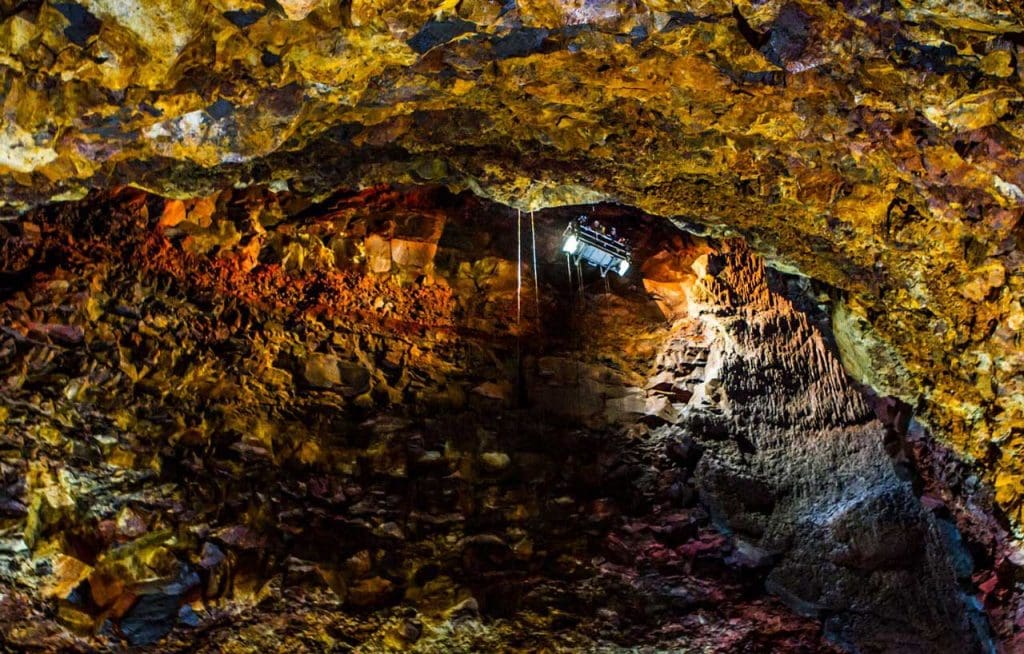
3. Bathe in a tub of geothermal beer in North Iceland
Discover Iceland’s first geothermal Beer Spa, where relaxation meets nature. Immerse yourself in a warm beer bath, combining young beer, live yeast, hops, beer oil, and salt, all in naturally heated geothermal water. This unique spa treatment, with a beer yeast tablet, rejuvenates your skin and overall health.
The beer bath, set at 37-39°C, is not just for pampering; it also benefits your hair and skin, thanks to the low pH of the fermenting beer. Bathe solo or with a companion, regardless of age, in Kambala wood tubs. While the bathwater isn’t drinkable, adults over 20 can enjoy a beer draught right at their tub. Visitors under 16 must be accompanied by an adult.
Experience this one-of-a-kind indulgence in Iceland—where you can sip a cold beer as you soak in a beer bath.
The Best Time to Do This: All year
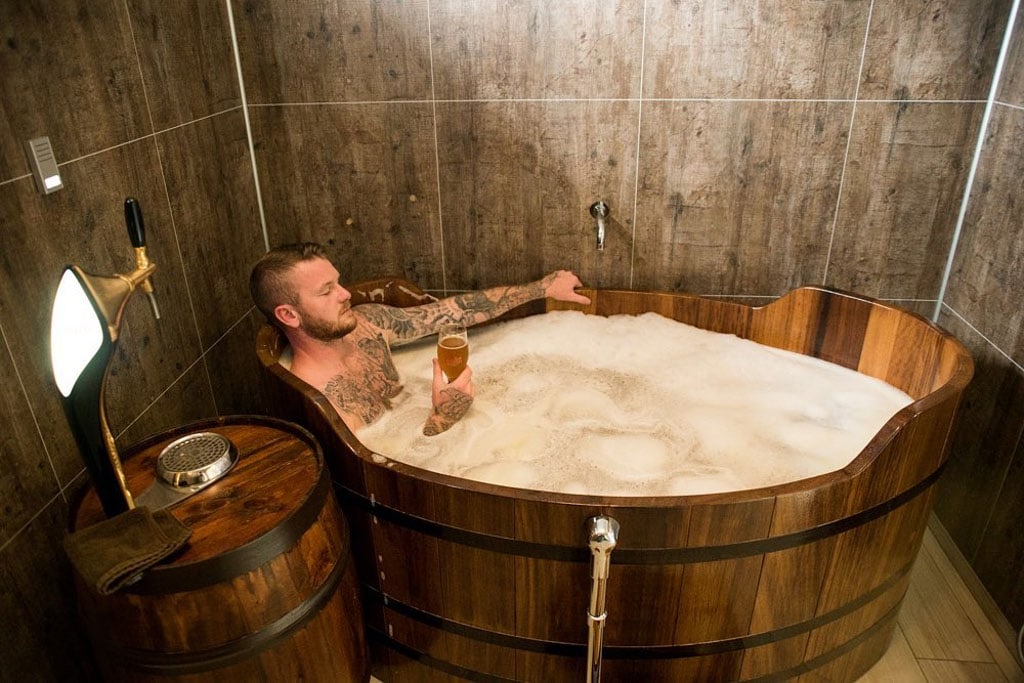
4. Go snorkelling or diving between the tectonic plates in the Silfra Fissure
Diving and snorkelling are activities that can be enjoyed worldwide, but Iceland is the only place on Earth where you can do so in the gap between two continental plates. Silfra Fissure, a natural rift between the North American and Eurasian plates, is filled with fresh water.
Divers from all over the world travel to Iceland just to experience the beauty of Silfra Fissure. Not only is Silfra unique for its location between two continental plates, but it has the clearest fresh water and the greatest underwater visibility in the world. It’s no wonder that Silfra is on the bucket list of so many divers!
Another wonderful aspect of Silfra is its ease of access. There is no need to get in a boat and sail out somewhere or dive deep into underwater caverns to enjoy Silfra. The only requirement for healthy, adventurous people who know how to swim is that you sign up for a diving or snorkelling tour. Then, you can experience the incredible sensation of being in the gap between the tectonic plates for yourself.
The Best Time to Do This: All year
5. Go for a swim in the Atlantic Ocean
While swimming in the cold North Atlantic might not seem too appealing at first, it’s an activity that is steadily gaining in popularity. The Icelandic people have been taking dips in these waters for hundreds of years and the practice still continues.
Not only is swimming in the North Atlantic an invigorating adventure, but it’s also rumored to be good for the immune system. In summer, the water can get up to 12-15ºC (53-59ºF), while in winter, it can go below 0ºC (32ºF).
Nautholsvik Geothermal Beach is one of the most popular locations to swim in the North Atlantic. Not only does this local paradise have golden sand and a great view, but it also has a hot tub and a steam bath. The small lagoon uses water from the hot tubs to warm its waters to a tolerable 15-17ºC (59-62ºF). The temperature can be a bit lower in the winter, though. You can grill your own lunch and swim in the freezing cold waters in one memorable afternoon! While the beach can get busy during the summer, locals use the Nautholsvik Geothermal Beach all year.
The Best Time to Do This: All year

6. See Iceland from above from a helicopter
The country of Iceland may be relatively small, but it’s packed full of things to see. Visiting Iceland in a vehicle can take days to see these beautiful sights. But, from above, all of Iceland’s most attractive secrets can fit into one fantastic tour.
What better way to see Iceland from above than by helicopter? A helicopter tour will ensure you have access to the most impressive views and access to otherwise unreachable areas. You’ll also get to do so while comfortably seated, out of reach of the crowds of tourists.
If you are having problems fitting everything you want into your trip to Iceland, this could be the perfect time-saving solution! The adrenaline felt while riding a helicopter is another perk to this fantastic experience. You can easily see the most deserted and hard-to-access parts of the country while leaving the beaten roads behind.
The Best Time to Do This: All year

7. Go snowmobiling on a glacier
One of the most exhilarating activities that Iceland has to offer is definitely snowmobiling. The country has a number of incredible virgin ice caps on offer, which can be easily explored at high speeds on a snowmobile, without the need for physical exertion.
With a twist of the wrist, you can begin the unique experience of flying across the top of a breathtaking ice cap. The wind in your face, the sound of the motor, and the scenic views are sure to create a lifelong memory.
In Iceland, the three most popular locations for snowmobiling are the Vatnajökull, Mýrdalsjökull, and Langjökull ice caps. Snowmobiling on Langjökull is often combined with the Golden Circle sightseeing route so you can cross two things off your bucket list in one go!
The Best Time to Do This: All year
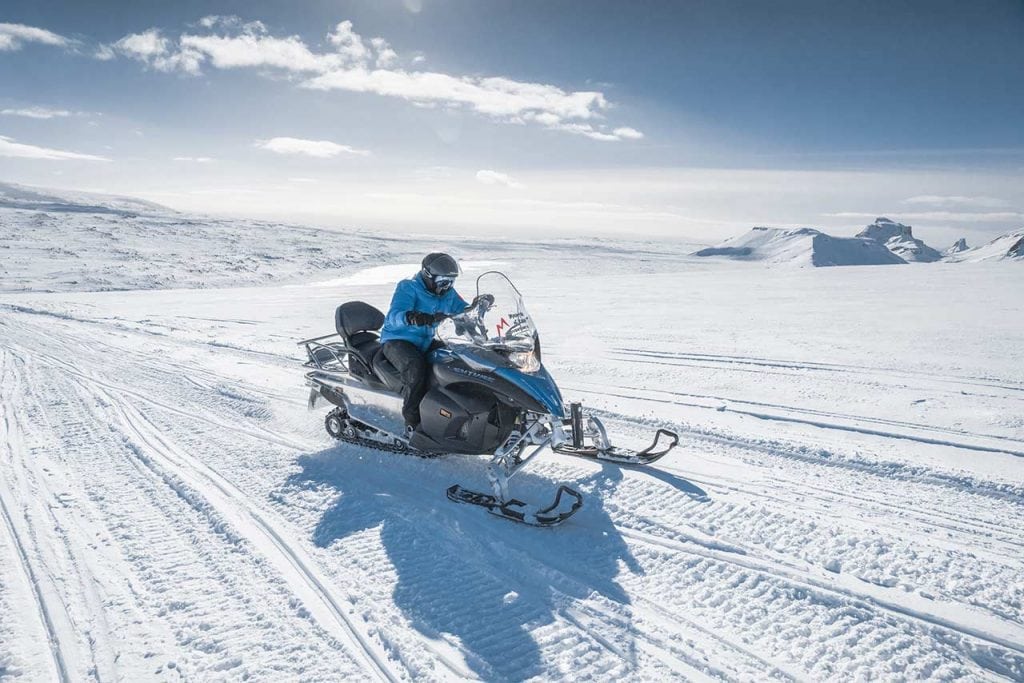
8. Visit the filming locations for Game of Thrones
For those visitors to Iceland who are also fans of the HBO series Game of Thrones, the country has an extra reason for you to visit. Iceland was the filming location for many of the epic TV series scenes, especially those that required snow and ice, such as north of the Wall.
Many filming locations are easy to access as they lie close to the Ring Road. These are popular spots often visited by tourists for non-Game of Thrones reasons. Some other locations, though, are not as easy to access. Some, like those filmed on glaciers or those that can be accessed only by using F-roads, are closed in winter and require a 4×4 to get close to them.
We have created a handy Google Map with all Game of Thrones filming locations to help you locate them. You can find it here:
The Best Time to Do This: To see the greatest number of filming locations, it’s best to visit in summer as some of the sites are inaccessible in the winter.

9. Ride on horseback across a lava field
The most famous four-legged resident of Iceland is definitely the Icelandic horse. This isolated breed is known for its small size, short legs, and muscular body. It’s also famous for its five gaits, its ability to resist the harsh Icelandic climate, and its reliability.
As an animal that was once both an essential method of transport and a tool used for working, the Iceland horse holds a significant place in the traditional Icelandic lifestyle. Today, these beautiful animals are mostly used for leisure activities and enjoying nature. Exploring Iceland on horseback will allow visitors to see areas that are otherwise not accessible on foot or by car.
There are farms all around Iceland which offer the possibility of riding on horseback. While you may have ridden other breeds of horses, the Icelandic horse is generally softer and more pleasant to ride. Experience the beauty of Iceland while feeling as though you are flying over it in a saddle on the back of one of these majestic creatures. This is a true adventure that you should not miss out on.
The Best Time to Do This: All year
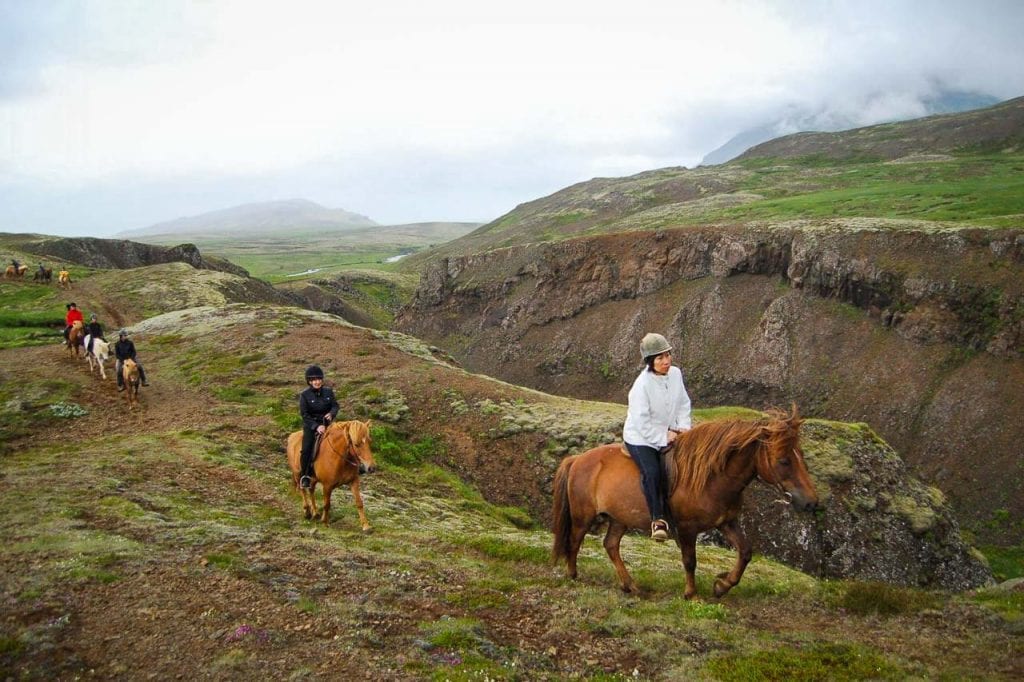
10. Explore the natural ice caves
Iceland is a country that is full of glaciers. For that reason, it’s the perfect place to visit an ice cave, a natural phenomenon that forms in glaciers in summer. This unique experience will make you feel as if you’re walking into the deep blue heart of the glacier itself.
In the summer, the melting ice caps give birth to glacial rivers, which carve ice caves into the glaciers’ interior. In the summer, these caves are still filled with water, making them impossible to explore. But, in winter, when the temperatures are cold enough for the water to freeze and stay frozen, it is safe to visit these frozen jewels lying hidden under the ice. When you walk into a glacier cave, the perfect blue color of the ice will carve itself into a place in your memory.
Ice cave season is generally between November and March. But, if the conditions allow, one natural ice cave is accessible year-round near Katla volcano. While the interior of this naturally-formed cave is not blue, it will still allow summer visitors to visit an ice cave.
The Best Time to Do This is from November to March; however, there are ice caves that are safe and accessible to visitors all year round.

11. Ride in a Super Jeep
When you think of Iceland, one of the first thoughts to come to mind is probably not monster trucks. But, super jeeps, with their oversized tires, have been steadily becoming more popular in the country as they are the best way to drive safely in snowy, icy winter conditions.
With a normal car, it’s impossible to access certain areas of the country in winter. This is especially true for the countryside. With a super jeep, you’ll have access to some of the most remote places in Iceland, such as the glaciers or the more remote corners of the Icelandic Highlands.
If you don’t feel comfortable driving one of these huge cars yourself, never fear! There are super jeep day tours offered, which go to many different locations. These tours suit everyone as they are safe and secure and employ expert guides.
The Best Time to Do This: All year

12. Explore Ásbyrgi canyon
Ásbyrgi is a unique horseshoe-shaped canyon in Iceland, with cliffs rising 100 m (328 ft.) above a 3.5 km (2.17 mi.) long and 1 km (0.62 mi.) wide floor. Home to a pond, Botnstjörn, and diverse vegetation, the canyon’s central feature is Eyjan, a 250 m (820 ft.) wide rock formation. The combination of cliffs, plateaus, and verdant vegetation make this area a photographer’s dream.
This striking landscape, a rarity in Iceland, is steeped in mythology and thought to have been formed by catastrophic glacial bursts from the Vatnajökull ice cap. Today, Ásbyrgi hosts one of Iceland’s best camping sites, conveniently located near the Ring Road and Dettifoss waterfall, making it an ideal base for exploration.
Ásbyrgi is part of the Diamon Circle tour route. Read more about it here.
The Best Time to Do This: All year

13. Visit the colourful mountains of Landmannalaugar
Innumerable magical landscapes are waiting for you to explore in Iceland. But there is only one place where you can find multicoloured mountains, twisting trails of lava, lakes with crystal clear water, and relaxing hot springs all in one place.
This incredible place is Landmannalaugar. The peaks of the mountains here are made of rhyolite. This mineral-rich lava is known for the rainbow of colours it can create as it slowly cools, creating a unique array of mountain peaks standing proud in their finery against the Icelandic sky.
For those interested in hiking, one of the best trails in Iceland begins here in Landmannalaugar. The trail takes you over rainbow-coloured hills, jet-black volcanic deserts, mystical ice caves, and heavenly green valleys.
The Best Time to Do This is in summer, from June to September. The roads to Landmannalaugar are closed during the rest of the year, making it impossible to access the site.
14. Spend the night in an Icelandic church
In the village of Stöðvarfjörður in East Iceland is a tiny church. This gorgeous building, named Kirkjubaer, is no longer a church. It has been remodelled and is now being used as a hostel.
The building sets itself apart from the rest of the village so you won’t get lost on your way home! The church-turned-hostel offers guests everything they need for a comfortable stay, including a kitchen, bathroom, and shower.
This warm and welcoming accommodation is also very unique. The altar is still inside, as well as some other sacral items. Keep warm and well-rested in a place, unlike all others in the country.
The Best Time to Do This: All year.

15. Witness the Northern Lights
The Northern Lights, also known as the Aurora Borealis, are one of the biggest attractions for tourists visiting the country. This natural light display can only be seen in the winter in the world’s northernmost countries. The Northern Lights are definitely something to be experienced in person, and Iceland is the perfect place to do so.
In Iceland, the Northern Lights can be seen for eight months of the year, beginning in late August and ending in April. No experience can match the sight of the dark night sky speckled by stars and decorated by a dancing wave of colours. These undulating strands of green, purple, and pale pink light are a must-see natural phenomenon.
Embark on a luxurious adventure with our exclusive Super Jeep tour, accessing remote Icelandic areas unreachable by regular cars. Ideal for Northern Lights viewing, these tours escape urban light pollution, even near Reykjavik.
The Best Time to Do This: From September to April
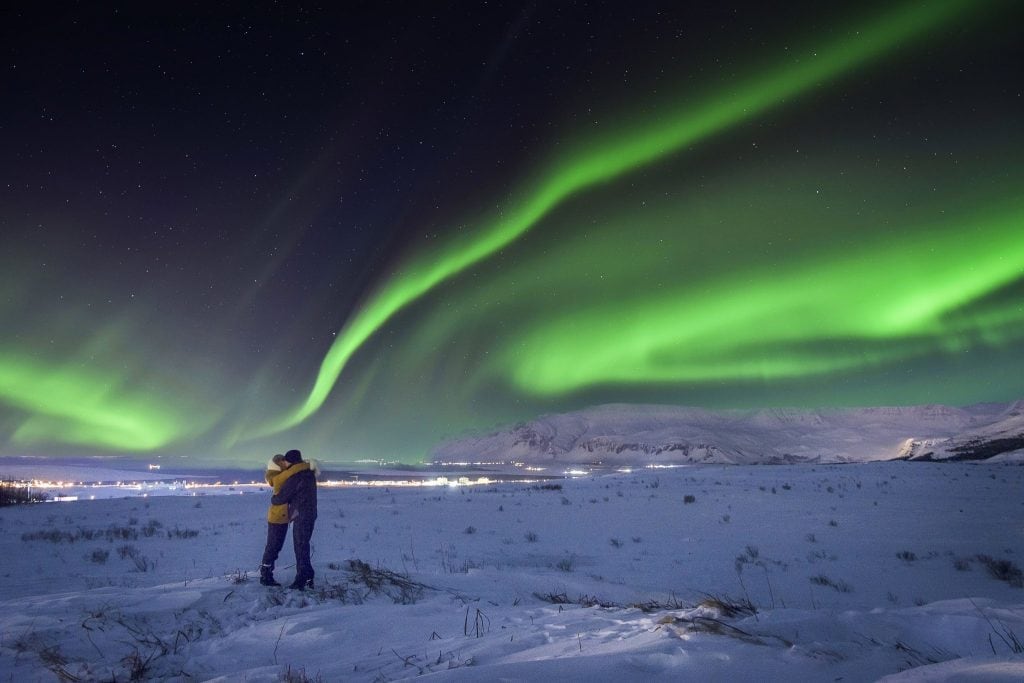
16. Take a scenic walk through Arnarstapi
Arnarstapi, a quaint fishing village on the Snæfellsnes Peninsula, boasts a beautiful natural harbor with unique basalt columns and cliffs. Less touristy, it offers an authentic Icelandic experience. Enjoy the impressive Bardur Snaefellsnes statue and nearby Gatklettur, the “arch rock”, along with other stunning formations.
A scenic hiking trail connects Arnarstapi to Hellnar, meandering through lava fields and coastal landscapes over 2.5 km. Perfect for a leisurely hour-long walk, this path showcases the area’s natural beauty. Arnarstapi is a must-visit gem on the Snæfellsnes Peninsula, captivating visitors year-round. If you are visiting the Snæfellsnes Peninsula, this town is worth the stop. It is an absolute gem! Book a private Snaefellsnes tour here.
The Best Time to Do This: All year
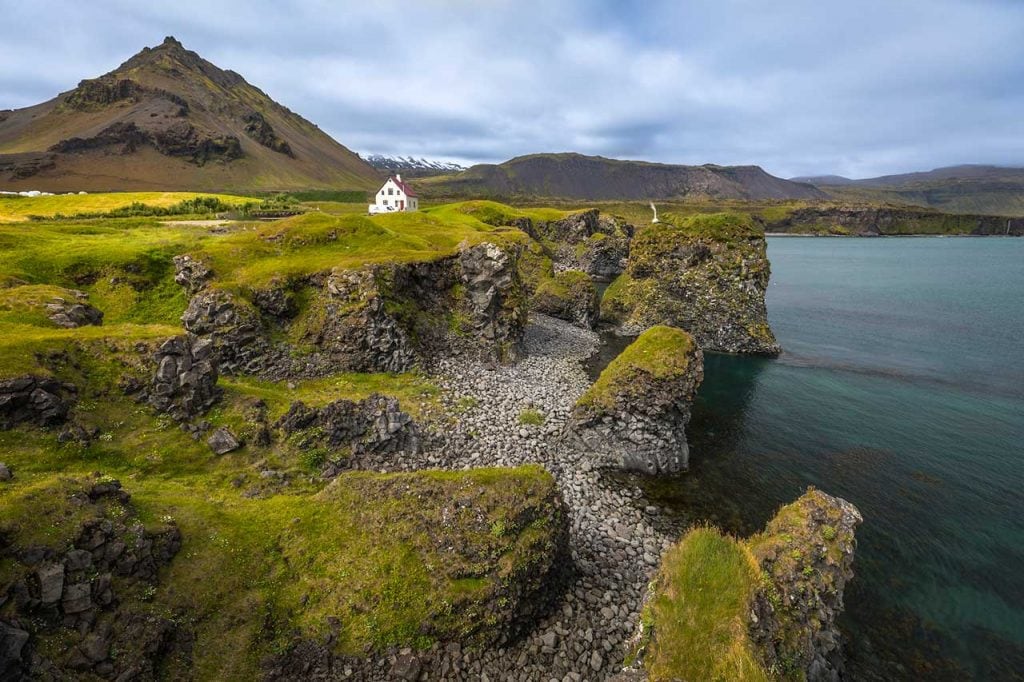
17. Go whale watching in North Iceland
Over twenty species of whale, dolphin, and porpoise can be found off the coast of Iceland. This is why Iceland is a top destination for whale watchers. Boat tours leave from ports in Reykjavík and Akureyri, while the most successful tours leave from the northern towns of Húsavík and Dalvík. In places like the Westfjords, it is possible to whale watch from the shore without setting foot on a boat.
Humpback whales, white-beaked dolphins, and harbor porpoises can be seen almost daily while a few lucky visitors will have the opportunity to see other species, including orcas, fin whales, blue whales, or even narwhals. Aside from the sea mammals, there are also a variety of seabirds, including skuas, Arctic terns, guillemots, and the colorful, adorable puffin.
When whale watching, you will be given the option of smaller powerboats or larger vessels. The smaller boats are for smaller, more intimate groups and can get closer to the animals because their motors are much quieter. On the other hand, the larger vehicles are for larger tour groups and have much better tracking technology to ensure better chances of seeing a whale.
The Best Time to Do This: All year

18. See the puffins in Borgarfjörður Eystri
One of the most emblematic animals in the country, the Atlantic puffin, is a big draw for tourists. These cute black and white birds, with their brightly colored beaks and webbed feet, can be found all over Iceland. This is because over half of the world’s Atlantic puffins nest in Iceland each year, making Iceland home to the largest puffins in the world.
While it can be difficult to see puffins in the wild because their colonies tend to be far from shore, the best place to observe them is the small village of Borgarfjörður Eystri in East Iceland. Unlike many other places in Iceland, in this village, you can get up close to the birds quite easily.
Near the island is a rock formation with steps and paths that you can explore while the adorable puffins bustle nearby. Hundreds of birds busily surround these paths, flying, landing, hunting, flirting, or simply resting. The landscape here is very picturesque as well – as if the sight of puffins up close and personal wasn’t enough to make you want to visit!
The Best Time to Do This is from late April to mid-August
19. Go kayaking among the icebergs on a glacier lagoon
One of the most famous of the spectacular sights Iceland offers is Jökulsárlón. This is a glacier lagoon that formed from the tongue of Breiðamerkurjökull glacier. Even if you aren’t planning to travel Iceland’s famous Ring Road, Jökulsárlón is worth visiting.
Jökulsárlón lies on Route 1 and is impossible to miss. While most tourists just go to the glacier lagoon to take pictures, you can take the adventure one step further and go kayaking on the glacier lagoon! This unique opportunity is a way to synchronize yourself with pure nature further.
Paddling around the glacier lagoon will allow you to experience the glacier from a new perspective. During this adventure, you’ll have the opportunity to see the glacier from a new angle! If you’re lucky, you might even come across some friendly seals while on the water.
The Best Time to Do This: From May to September

20. Try Iceland’s most authentic Hot Spring Resort in the Whale Fjord
Hvammsvík Natural Hot Springs is the ultimate choice for those who want to try the most authentic Icelandic nature experience while having the opportunity to reserve your spot and shower, change and dine in comfort – things that aren’t possible near wilderness hot springs.
Hvammsvík, a secluded 1200-acre estate just 45 minutes from Reykjavik, offers a unique Icelandic nature experience with eight diverse natural hot springs, a steam cave, and a variety of wildlife. This remote fjord, surrounded by ocean, mountains, and local fauna like birds and wild sheep, provides ever-changing bathing experiences in harmony with the tides. The site, rich in history and nature, features facilities inspired by its 12th-century origins. Enjoy geothermal waters mixed with seawater for optimal cleanliness, and savor local dishes at the on-site bistro, including seafood soup and an algae/ginger shot. Experience year-round relaxation in hot springs on the ocean’s edge at Hvammsvík.
The Best Time to Do This: All year
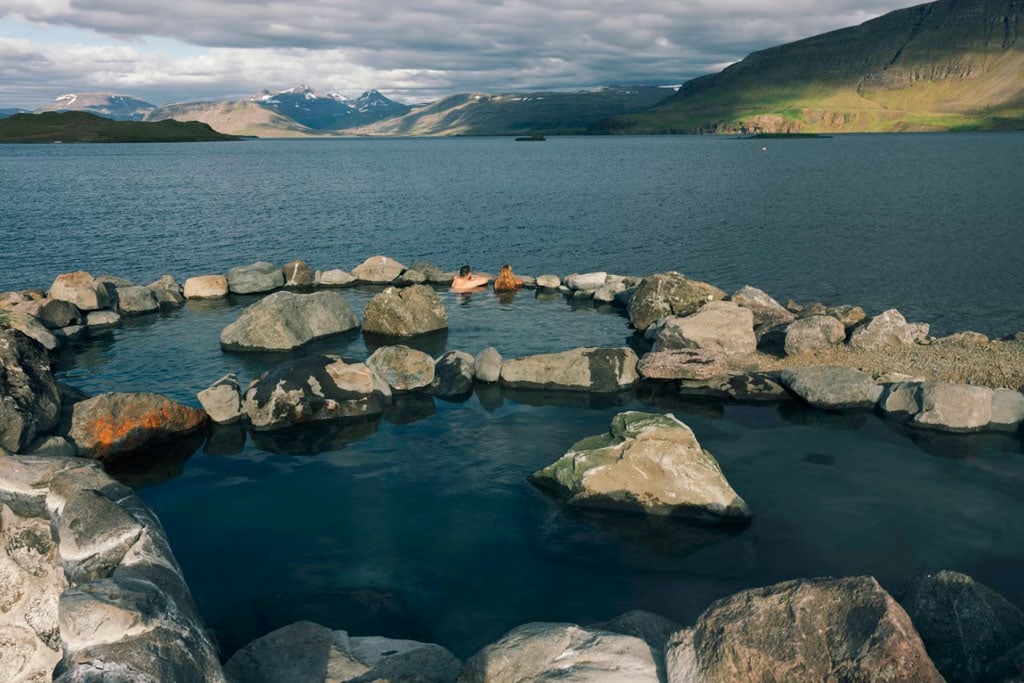
21. Bathe in a hot geothermal river in Reykjadalur
Iceland boasts a diverse array of hot springs and natural baths, from roadside pools to renowned spas with stunning blue waters. Reykjadalur Valley, just 45 km (28 mi) from Reykjavík, is known for its hot springs and mud pools, aptly named “Steam Valley.” The valley’s main attraction, however, is the hot river that flows through it, offering a unique bathing experience. To reach this geothermal wonder, a one-hour hike is required, necessitating good hiking boots in summer and crampons in winter due to slippery or icy conditions.
The river’s bathing area has water temperatures ranging from 35-45ºC (95-113ºF). Caution is advised as temperatures can vary, and it’s always wise to test the water before entering. The water gets hotter upstream, but can cool down after heavy rain. Despite its popularity with tourists, Reykjadalur’s hot river provides ample space for a relaxing soak in its naturally heated waters.
The Best Time to Do This: All year
22. Celebrate the Anticipated Reopening of Iceland’s Blue Lagoon
As of December 2023, the renowned Blue Lagoon in Iceland has sadly been temporarily closed due to seismic activity in the area. However, with seismic activity gradually decreasing, there’s hope for its reopening soon. And when it does, let’s eagerly flock there to join the celebration!
Known for its milky blue geothermal waters amidst stark lava fields, the Blue Lagoon is a top destination for relaxation and skin care, drawing tourists globally to its otherworldly landscapes. This vast spa, set in the volcanic Reykjanes Peninsula, offers unique experiences like silica mud masks and a swim-up bar. While it’s a year-round attraction, it’s typically less crowded in the winter months, especially December and January, providing a more serene experience. Keep an eye out for updates on its reopening to enjoy one of Iceland’s most iconic and therapeutic destinations.
The Best Time to Do This: As one of Iceland’s most popular attractions, the Blue Lagoon tends to have its biggest crowds between May and September, with a peak in July and August. The winter months are generally calmer, particularly December and January.
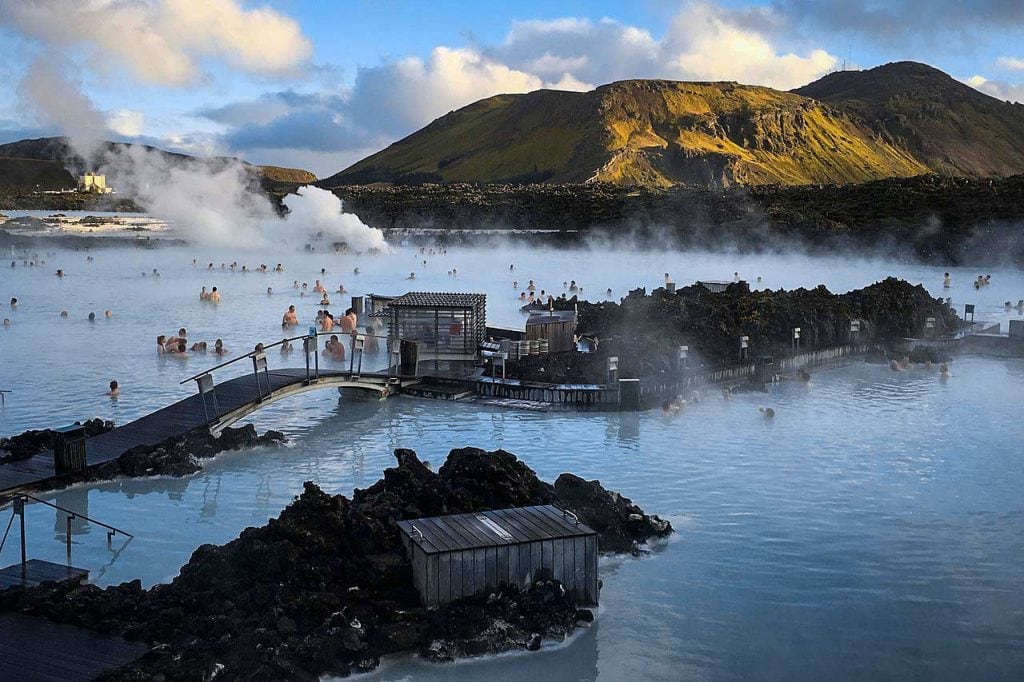
23. Visit a spectacular lava cave!
Iceland is covered by huge lava fields as a consequence of numerous volcanic eruptions throughout the years. A plethora of spectacular caves and tunnels are hidden within the lava fields and await curious visitors to explore them. These natural caves feature an incredibly diverse and colorful scenery filled with distinctive features and curious rock formations such as stalagmites and stalactites.
In winter, you will likely see glistening natural ice sculptures in the cave, adding further beauty to the already otherworldly scene.
Get up close and personal and explore a lava cave from the inside; these incredible places offer a fascinating adventure into the earth! Visiting a lava cave can be done via guided tours; find your options here.
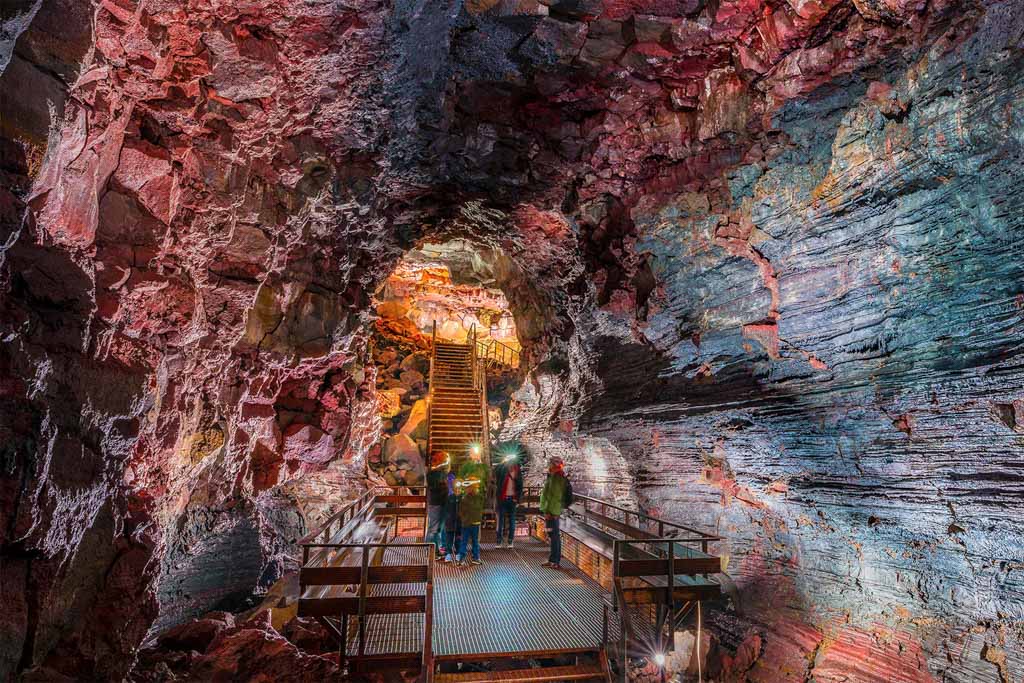
24. Try the New Mega Zipline on Hveragerdi
For an exhilarating addition to your Icelandic adventure in 2024, don’t miss the Mega Zipline in Hveragerði. This attraction stands out as Iceland’s longest and one of Europe’s most scenic ziplines. Glide over the Svartagljúfur canyon, experiencing the thrill of soaring through the air with a spectacular bird’s-eye view of Iceland’s landscapes. The Mega Zipline offers two unique experiences: a traditional seated ride or the more intense “Superman ride,” where you fly head-first, reaching speeds up to 120 km/h (74.5 mph). This adventure, blending safety and excitement, promises to be a highlight of your Icelandic journey.
The Best Time to Do This: All year


